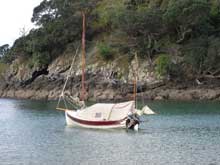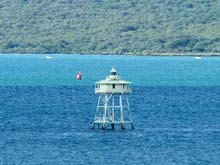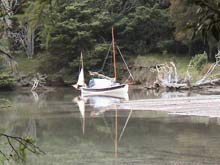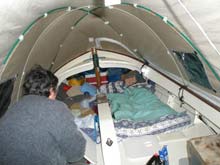Like many New Zealanders, the Labour Day long weekend at the
end of October feels like the symbolic start of summer to me.
In fact, the late autumn and early summer here are often full
of stormy weather systems rolling up from the Southern Ocean,
and this year is proving no exception.
This year my wife Barb and I decided to take an extra couple
of days off, and have a shakedown cruise in our Pathfinder
‘Varuna’. The long range weather forecast
was promising windy conditions but with five days available
we decided to head off, keep a close watch on the weather and
plan our trip around what developed.
Our original plan had been to sail North from Auckland on Friday
morning, along with the large fleet of yachts setting off on
the Coastal Classic, an annual race 120 miles north up the coast
between Auckland and Russell. We did this last year and had
a great sail up the coast for 15 miles in a freshening southwester.
We were being overtaken all morning by the yachts in the race;
at the head of the fleet the eventual winner of line honours,
a giant 55 foot yellow catamaran called X-Factor was a spectacular
sight rocketing past us with spray smoking off the bows. In
the early afternoon we veered off to spend the night camped
a little way up the Mahurangi River and then spent a superb
couple of days sailing and camping around the islands in the
area. We scurried home on Monday with towering black storm clouds
chasing us down the gulf.
 |
Last year we spend a superb
couple of days camping and sailing in the Hauraki Gulf. |
The forecast this year was promising 30 knots for race morning,
so we modified our plans a bit.
Thursday lunchtime found us at the launch ramp casting off
on a day that was mostly sunny, but punctuated with showers
rolling in from the SW. We motored out through the moorings,
and then set sail for our first way-point, the Bean Rock lighthouse
which stands in the entrance to Auckland Harbour.
There was little breeze and we sailed slowly down wind towards
the Motuhie Channel about 5 miles off. Occasional showers of
cold rain were a mixed blessing, with the wind picking up for
a while as each one got close. It was great to be out sailing
again, and we were making steady if slow progress.
The Motuihe Channel had its smiley face on today, it is notorious
for nasty steep waves with the wind against the tide. By the
time we got there the SW wind had started to pick up a bit and
become steady. Once we rounded the NE point of Waiheke Island
the rugged North coast of the island offered plenty of places
where we could get shelter from the strong SW winds expected
overnight. This coast is deeply indented with bays and coves,
sandy beaches, rocky cliffs and reefs all along. Not a great
place for any boat in a northerly, but it's a paradise for small
boat cruisers and fishermen in good conditions.
Our destination 6 miles further on was Garden Cove, a little
jewel of a bay deeply indented into the island with a golden
sandy beach and rough and steep farmland rising behind.
| Our first way-point: the Bean Rock lighthouse
which stands in the entrance to Auckland Harbour. |

|
The entrance is a narrow gap between a rock and the shore.
By the time we got near the wind had picked up to about 20 kts,
the showers had become heavy and squally, so we were happy to
get through the little gap and into shelter. Once we did it
was like a switch had been flicked, the sun came out again almost
perfectly on cue, we were out of the wind and swell, and we
were happy campers.
After going ashore for a while to stretch our legs, we anchored
just off the beach, got the tent set up on the boat, and settled
back to enjoy the peace and quiet. We had the cove to ourselves,
the billy boiling on the stove, and all was well with the world.
During the night the wind got up and some heavy showers of
rain gave the tent it's first real test; by the early hours
of the morning we were being buffeted by strong gusts and very
pleased to be in such a snug anchorage. The morning revealed
a beautiful sunny day, with a strong SW blowing. We decided
we would stay put for the day and spent the morning ashore,
exploring the hills and the coastline. This is a very rugged
rocky shoreline, with steep slopes of rough farmland, bush and
scrub tumbling down to little shingly beaches, interspersed
with rocky points and reefs. My thought’s kept wandering
back to the fishing gear still safely stowed back on the boat,
maybe next time.
Back on board we had a late lunch and spent a lazy afternoon
reading and sleeping in the warm sunshine. The thought that
it was a working day only added to the enjoyment.
We were joined in the cove later that evening by a forty foot
flying-bridge launch and smaller fishing boat. It was very calm
in the bay overnight, but got quite cold in the early morning.
 |
Garden Cove: a little
jewel of a bay deeply indented into the island with a
golden sandy beach and rough and steep farmland rising
behind. |
The next day we had to make a choice. We could continue on
around Waiheke Island, and then down it's sheltered East coast
towards some of our favourite sailing and camping spots. The
other option was to return towards home, and spend a night or
two in some of the sheltered bays around the islands along that
way. Listening to the weather forecast soon convinced us that
we should opt for the much shorter second option. There were
strong winds promised by nightfall, and 25 knots for each of
the next couple of days as well.
We set off in warm sunny conditions with thoughts of a picnic
lunch at the Noises, a group of small islands about 8 miles
to the NE.
The wind and weather were coming from the SW, and we should
have taken a bit more notice of the gradually rising wind and
some black clouds dumping rain as they moved slowly towards
us over the islands. We were sailing along nicely, close hauled
in a steady breeze, and by the time it suddenly occurred to
me that reefing might be a good idea it was too late to do much
more than sail the boat. We soon had to round up into the wind
and drop the main. It's moments like this that you appreciate
lazy jacks, a simple rig and two masts. We were soon sailing
again under mizzen and jib, but thoughts of our picnic lunch
had disappeared with the sunshine. We sailed on to Rakino Island,
and then motored into Sandy Bay for a brew up and some lunch.
By now it was a different day, with some very strong gusts
of wind so our first objective was finding somewhere sheltered
to spend the night. Rakino Island itself offered some possibilities
but after a short trip across the Rakino Channel the east coast
of Motutapu Island would also offer several good sheltered bays
and a long rocky coastline where we could get in close sheltered
by the land. With the strong winds forecast for the next few
days the only likely looking window of opportunity for the last
leg back home to Auckland would be the following night when
a 15 knot Westerly was predicted. We decided we should try to
cover as much of the remaining trip today, and thought Islington
Bay would probably be the best outcome; but were prepared to
stop anywhere suitable along the way if the conditions deteriated.
We spent the next hour or so motoring across the channel and
down the island where all of the bays already had groups of
boats settled in for the night. The only real obstacle now between
us and Islington Bay was Emu Point. Rounding this point at the
south end of Islington Bay would expose us to the full force
of the wind and waves sweeping down a 6 mile stretch of open
harbour that leads back to Auckland. We crept up to the point
close in to the shore, sheltered by the high cliffs, and decided
to carry on; and other than being a bit bumpy and wet we had
no problems and were soon in the shelter of the bay; relieved
to be able to stop and get settled in for what was promising
to be a rough night.
| In the shelter of Islington Bay; relieved
to be able to stop and get settled in for what was promising
to be a rough night. |

|
Islington Bay is a deep V formed by the shorelines of Motutapu
and Rangitoto Islands, and we crept in as close as we could
to the Rangitoto shore and anchored in the lee of the land.
There were probably 30 other boats already at anchor here with
more arriving as the day died. We were getting blown around
at anchor in the strong gusts of wind and several times during
the night I thought the tent would get blown off the boat. In
the morning the gusts were howling through, and we were in no
hurry to get the day started. We lay in bed reading and dozing
most of the morning. The forecast for the day was for the wind
to drop by evening to 20 knots, and then change to a 15kt Westerly
during the night. I started monitoring automated wind readings
broadcast on VHF; the three closest stations were reporting
average wind speeds close to 40 knots at 11am, with a peak gust
of over fifty knots reported from one of them. We decided we
would wait where we were until the average at Bean Rock dropped
to below 20 knots, and then pack up and see if the conditions
outside the bay would let us get back home.
Just after midday we were blown off our anchor. I looked out
of the tent during a big gust and discovered we were drifting
rapidly downwind onto a large launch anchored behind us. Luckily
one of the people on the launch saw us coming and fended us
off their bow before we hit them. I got the motor running and
we anchored again even closer in to the shoreline. Our anchor
had pulled gently out of the mud after 20 hours, and the thought
that it could have just as easily have happened in the middle
of the night while we were asleep was a sobering one.
During the afternoon the wind in the bay dropped off markedly,
but there were still strong gusts blasting through regularly,
and the sea outside the bay was wild with whitecaps.
By 3:00 pm the wind at Bean Rock had dropped to 30 knots, at
8:00 it was 22 knots, and finally at 10pm it had fallen 19.
We packed the tent up, reefed the main and set off at about
11:00pm. It became apparent as soon as we cleared the bay that
it was going to be a very long night if we attempted the trip
under sail, so we started the motor. There were about 6 miles
to cover directly upwind, but the wind and waves had dropped
sufficiently to make it a relatively comfortable trip. We took
quite a bit of spray over the bow, but had wrapped up in all
our gear so stayed warm. By 1:30 am we had the boat ashore and
unrigged, and an hour later were crawling thankfully into a
warm bed at home.
When I finally opened a bleary eye in the middle of the morning,
the wind was buffeting the house and it was raining hard. Bean
Rock was reporting gusts around 50 knots; it felt good to be
home.
This turned out to be a pretty good shakedown cruise, and we
both enjoyed getting away in the boat again.
We had a 30 hour stretch aboard, and were still talking to
each other at the end of it. We encountered winds stronger than
we would usually choose to be sailing in, the tent stayed up,
we didn't break anything and learnt a couple of timely lessons.
I will be paying much more attention to setting the anchor properly
when we sleep aboard in future, and adding a couple of metres
more chain to it as well. We will also be watching deteriorating
weather much more closely, and reefing early. The squall that
caught us out was onto us before I even considered we might
need to shorten the sail.
Bring on that summer weather :-)
Frank Bates
 |
Click the image to the left to see a large, interactive Google map of the course |

